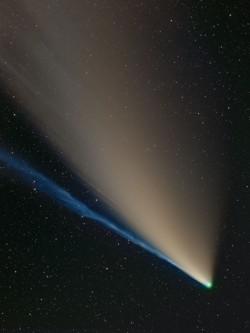Glossary term: Coma cometária
Description: À medida que um cometa se aproxima do Sol, parte das substâncias sólidas ligadas ao núcleo gelado do cometa se transforma em gás. Esse gás, que consiste principalmente de água, mas também contém outros produtos químicos, como monóxido de carbono, dióxido de carbono, amônia, metano e metanol, bem como partículas de poeira, envolve o núcleo como uma nuvem esférica e difusa, que é chamada de atmosfera cometária ou coma. À medida que o cometa se aproxima do Sol, mais e mais moléculas são divididas pelos fótons ultravioletas do Sol, aquecendo a coma e fazendo com que suas regiões externas se expandam. Por fim, as regiões externas são ionizadas, formando a cauda iônica do cometa.
Related Terms:
See this term in other languages
Term and definition status: The original definition of this term in English have been approved by a research astronomer and a teacher The translation of this term and its definition is still awaiting approval
The OAE Multilingual Glossary is a project of the IAU Office of Astronomy for Education (OAE) in collaboration with the IAU Office of Astronomy Outreach (OAO). The terms and definitions were chosen, written and reviewed by a collective effort from the OAE, the OAE Centers and Nodes, the OAE National Astronomy Education Coordinators (NAECs) and other volunteers. You can find a full list of credits here. All glossary terms and their definitions are released under a Creative Commons CC BY-4.0 license and should be credited to "IAU OAE".
If you notice a factual or translation error in this glossary term or definition then please get in touch.
Related Media
Comet C/2020F3 (Neowise) with separate dust and ion gas tails and a green glowing coma, by Dietmar Gutermuth, Germany
Credit: Dietmar Gutermuth/IAU OAE
License: CC-BY-4.0 Creative Commons Attribution 4.0 International (CC BY 4.0) icons









